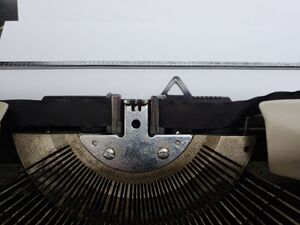Difference between revisions of "Kong Byung-Woo Typewriter"
m (→Basic Info) |
|||
| (3 intermediate revisions by 2 users not shown) | |||
| Line 1: | Line 1: | ||
| − | The Kong Byung-Woo Typewriter, also known as 3-Set Hangul Typewriter, is the first of [[Hangul Typewriter]]s to implement Syllable-based [[Hangul]] writing system along with | + | The Kong Byung-Woo Typewriter, also known as 3-Set Hangul Typewriter, is the first of [[Hangul Typewriter]]s to implement Syllable-based [[Hangul]] writing system along with left-to-right writing. |
== Basic Info == | == Basic Info == | ||
| − | [[File:Dual Type Guide.jpeg|thumb]] | + | [[File:Dual Type Guide.jpeg|thumb|right|Note the appearance of the type guide]] |
These typewriters have two type guides, while most of the common typewriters have only one. Among with the two guides arranged side by side, typebars for consonant, vowel, and some symbols are aligned for the right one. Their keys also moves the cursor forward, so syllables composed with consonant and vowel occupy two units of the character width. | These typewriters have two type guides, while most of the common typewriters have only one. Among with the two guides arranged side by side, typebars for consonant, vowel, and some symbols are aligned for the right one. Their keys also moves the cursor forward, so syllables composed with consonant and vowel occupy two units of the character width. | ||
| Line 10: | Line 10: | ||
== History == | == History == | ||
| + | The position of some minor keys like symbols, numbers, and less used final consonants has changed frequently for decades, due to differences of the base model and purpose of the machine. | ||
| + | |||
| + | There were also some major changes to the layout, like changes of position of frequent letters due to some reasons. | ||
| + | * The position of Initial consonants ㅅ and ㄹ has been swapped to reduce [[jamming]] in the 1960s | ||
| + | * The entire layout of Final consonants in Korean & English (bilingual) models were rearranged, and English layout were shifted two columns right, for taking apart each other to simplify the mechanism. | ||
Latest revision as of 06:54, 15 December 2022
The Kong Byung-Woo Typewriter, also known as 3-Set Hangul Typewriter, is the first of Hangul Typewriters to implement Syllable-based Hangul writing system along with left-to-right writing.
Basic Info
These typewriters have two type guides, while most of the common typewriters have only one. Among with the two guides arranged side by side, typebars for consonant, vowel, and some symbols are aligned for the right one. Their keys also moves the cursor forward, so syllables composed with consonant and vowel occupy two units of the character width.
Meanwhile, only typebars with Hangul 'final consonant' on it are aligned to fit in the left guide. They print their letters(final consonants) one unit left without advancing the cursor. This results in a complete syllable with consonant, vowel, and the optional final consonant, printed in place together, still occupying two units of width.
History
The position of some minor keys like symbols, numbers, and less used final consonants has changed frequently for decades, due to differences of the base model and purpose of the machine.
There were also some major changes to the layout, like changes of position of frequent letters due to some reasons.
- The position of Initial consonants ㅅ and ㄹ has been swapped to reduce jamming in the 1960s
- The entire layout of Final consonants in Korean & English (bilingual) models were rearranged, and English layout were shifted two columns right, for taking apart each other to simplify the mechanism.
